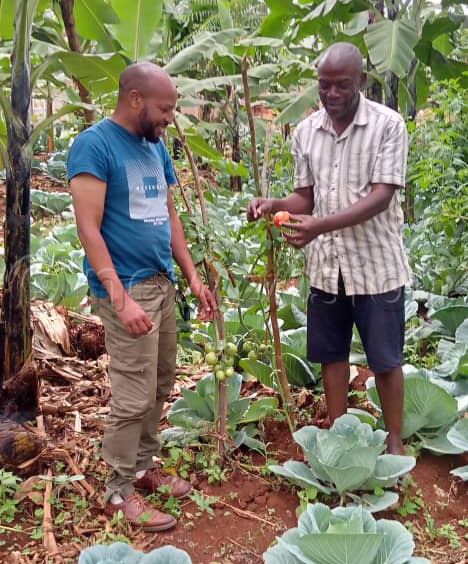How climate change is forcing Bugisu to kiss bananas goodbye
Musoba says massive deforestation in the Elgon sub-region has exposed the banana plants to violent storms. Bugisu sis one of the most deforested areas in Uganda, where natives engaged in endless wars with the National Forestry Authority over encroachment on the Mt Elgon National Park.
A banana plantation recovering from effects of a prolonged dry spell in Manafwa district.
By Sam Wakhakha
Journalists @New Vision
It is 6:00pm and 75-year-old Difasi Wamono, a resident of Buwaya trading centre in Manafwa district is returning home from the shop with 250 grammes of maize flour and two tomatoes in a polythene bag.
Whereas Wamono managed to pay for the flour, he did not have enough money for the tomatoes.
He convinced the shopkeeper to give him the tomatoes on credit, promising to pay within two days. As he walked home with the raw materials for his dinner, Wamono started speaking alone, asking himself how a man who once had a three-acre banana plantation ended up buying food from the shop or sometimes sleeping on an empty stomach.
“What happened to this land of Masaba? I used to harvest big bunches of matooke, but now here I am buying a quarter a kilogramme of maize flour from the shop to survive. We have normalised posho, a meal which used to be eaten during periods of scarcity. Our main food is litoore (bananas) How times change!” he exclaimed as followed the narrow path to his mud and wattle house on the hillside.
Wamono’s plight is representative of what is happening across the six districts that make up the Bugisu sub-region. Bananas, which are the area’s staple food and cash crop have dwindled at unprecedented rates due to climate change over the last 20 years in Namisindwa, Manafwa, Bududa, Bulambuli, Mbale and Sironko districts.
Vincent Musoba, a farmer who has been growing bananas in the last 60 years, says until about two decades ago, Bugisu sub-region was one of the leading banana growing areas in Uganda.
He says bananas formed the economic base of the weekly markets around the sub-region. Traders from as far as Dar-es-salaam, Jinja, Kalangala, Nairobi and Kampala were regular visitors to the weekly markets that dotted the Bugisu landscape.
Trading centres such as Magodesi, Kabaale, Buwaya, Bukhaweka, Lwakhakha, Kamu, Bushika, Bududa, Kamu – which have since grown into rural townships started as matooke markets.
“Bananas were the lifeline of rural Bugisu because they were both cash and food crops. A farmer would harvest some to feed his family and sell the surplus for cash. What was unique about matooke is that a farmer harvested all year round,” Musoba explains.
Standing in his 90-year-old banana plantation that he inherited from his grandmother decades ago, Musoba seems to understand the severe effects that climate change has had on plantations across the Elgon sub-region in the last 80 years.
“The dry spells are extreme, while the storms have become more violent. Bananas cannot thrive in such an environment. In the dry spell, the plants wither and in the rainy season, they recover, but then get destroyed by the violent storms. So, the farmer gets zero harvest at the end of the year,” he says.
Musoba says massive deforestation in the Elgon sub-region has exposed the banana plants to violent storms. Bugisu sis one of the most deforested areas in Uganda, where natives engaged in endless wars with the National Forestry Authority over encroachment on the Mt Elgon National Park.
“There are no trees to act as windbreakers. In the dry spell, the bananas wither and when the rains come, the plantations begin recovering, but just as they are flowering, violent storms strike and raze them to the ground. This has left us insecure on both the dining table and the pocket,” he explains.
With banana production in decline, Musoba says the food chain in the region is now happening in reverse. Markets that used to be the region’s food exporting areas have now become ‘import’ areas. Trucks now bring in food to sell to villagers, unlike in the past, when it was villagers selling to the traders on the trucks.
“It is strange, but we now eat from shops. Shopkeepers buy flour from Mbale city and other places to sell to the villagers. Others who have children in urban areas send them money to buy it,” he says.
According to Musoba, matooke is Bugisu’s delicacy, yet it is scarce. This means that those who want to taste it have to dig deeper in their pockets because it is expensive. Currently, the matooke consumed in the region comes from as far Mbarara, Isingiro and Bushenyi, which are more than 500km away in western Uganda.
The trucks now park in the rural markets to sell matooke instead of buying from us as was the case during the matooke boom two decades ago.
“I did not imagine that a day would come when a truck from Mbarara would park at our Kaabale market to sell to us matooke. We are living in strange times,” Musoba says.
As a result, malnutrition and poverty in the sub-region has increased yet the population is also rapidly growing.
Moses Kisiibo explaining the best farming practices he applies to his banana plantation near Kabaale trading centre in Manafwa district. Kisiibo blames the decline in banana production in Bugisu on overlapping.
According to the 2024 national population census carried out by the Uganda Bureau of Statistics (UBOS), 59% of the households in the sub-region are food insecure.
The 2023/2024 National Household Survey results released by UBOS in May show that, whereas poverty declined in Uganda from 20.3% in 2019/20 to 16.1% in 2023/24, for Bugisu sub-region, it instead increased from 13.2% to 14.1%.
At 741 people per square kilometer, the area is also one of the most densely populated in Uganda.
Local leaders speak
Florence Katami, the current secretary for production in Manafwa district, blames the decline in banana yields on poor farming methods.
“Poor farming practices among farmers are largely to blame. We no longer make contours or mulch our plantations; we instead use the banana fibres for cooking due to shortage of wood fuel. In the past, fibres were purely used for mulching plantations so that they do not lose their moisture content,” she says.
Katami adds that the high population density and a high concentration of iron roofs have exacerbated soil erosion, which leads to loss of soil fertility.
Moses Kisibo, model farmer and veteran journalist, says the decline in banana production is a mix of many factors.
“The Government's overlapping policy on agricultural production (Plan for Modernisation of agriculture, National Agriculture Advisory Services, etc) re-tuned farmers focus on one crop and move into dangerous intercropping, bringing down the real banana production levels to almost zero,” he says.
Kisibo also explains that the absence of agricultural extension workers to nurture and skill up the small holder farmer is another factor.
“Many of the extension staff are half-baked in banana agronomics. They have advised farmers to plant elephant grass along terraces in banana plantations, yet the elephant grass is a haven for rodents. Heavy soil erosion at the volcanic Bukusu and Namisindwa mountains has left the slopes unproductive. All the nutrients are washed down to the Butaleja district,” he explains.
Decline in banana production means other aspects of life will be disrupted because they serve many purposes. The dry banana fibres are used for thatching hats/houses and weaving mats. The stems are used for livestock, especially cattle.
Environmentalist explains
Bob Natifu, the assistant commissioner for climate in the Ministry of Water and Environment, says the decline in banana production is a combination of many factors.
“I see these things in a cyclical way, and these breed many others in a casual way. Too much rain, too little rain, and none at all. Increased temperatures have led to increased pests and diseases which attack the fruits. For example, the problem with Manafwa generally is that we have two extremes: too much rain and extremely too little in the dry season. This increases the rate of evaporation transpiration in plants like bananas, which lose their firm standing on the ground and in the end get attacked by pests and diseases,” he says.
Natifu, who is also a native of Manafwa, says the heavy rains that the area receives have had a negative effect on the soils.
“Look at our volcanic soils carefully… We receive much rain, between 1300 and 1500 mm on average in the rainy season. This is, by Ugandan standards, much. It heavily pounds the soil and erodes the nutrients therein. What does this tell us? It tells us we might want to improve our practices by, among others, using manure management to improve the yields, digging galleys to trap the excessive rain we receive in the rainy season,” he explains.
Natifu also thinks that modernity could have introduced non-native varieties of bananas, especially through the National Agriculture Advisory Services.
“So the causes of this decline are in part due to increased soil degradation (there is a rain effect here) that has led to recent conversions of more forest land into crop land in marginal and sensitive mountain ecosystems. We have to turn to more sustainable production systems, except that they cost an arm and a leg for an ordinary farmer,” he explains.
